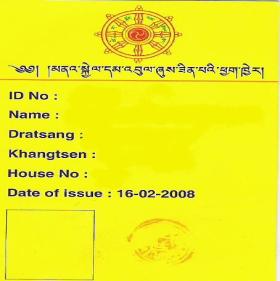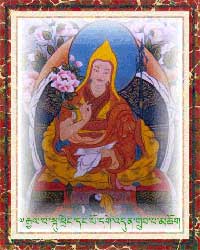
The Dalai Lama makes a great deal of being non-sectarian and claims that those who practise Dorje Shugden are sectarian. He quotes ‘sectarianism’ as one of his main reasons for banning the practice of Shugden:
2. Obstacles to the emergence of genuine non-sectarianism: His Holiness has often stated that one of his most important commitments is the promotion of inter-religious understanding and harmony. As part of this endeavour, His Holiness is committed to encouraging non-sectarianism in all schools of Tibetan Buddhism. In this matter, His Holiness is following the example set by his predecessors, specifically the Fifth Dalai Lama and the Thirteenth Dalai Lama. Not only is a non-sectarian approach mutually enriching for all Tibetan Buddhist schools, but it is also the best safeguard against a rise of sectarianism that could have damaging consequences for the Tibetan tradition as a whole. Given the acknowledged link between Dolgyal* worship and sectarianism, this particular practice remains a fundamental obstacle to fostering a genuine non-sectarian spirit within the Tibetan Buddhist tradition.
(*Dolgyal is a derogatory term for Dorje Shugden)
Bigotry, discrimination, hatred
So how non-sectarian is the Dalai Lama? This is the definition of sectarianism http://en.wikipedia.org/wiki/Sectarianism from Wikipedia:
 Sectarianism, according to one definition, is bigotry, discrimination or hatred arising from attaching importance to perceived differences between subdivisions within a group, such as between different denominations of a religion or factions of a political movement.
Sectarianism, according to one definition, is bigotry, discrimination or hatred arising from attaching importance to perceived differences between subdivisions within a group, such as between different denominations of a religion or factions of a political movement.
This definition contains many powerful words such as ‘bigotry, discrimination and hatred’, all of which apply to the Dalai Lama’s public pronouncements about the practice of Dorje Shugden. An enforced signature campaign to stop the practice has led to Tibetans practising bigotry and hatred towards those who disagree with the Dalai Lama’s political ban of the practice. Discrimination is exactly what Shugden practitioners are experiencing in Tibetan communities throughout the world (shockingly, even in democratic Western countries such as the USA, France and Switzerland) as the Dalai Lama brands them as spirit worshippers. Paradoxically, this makes the Dalai Lama’s own Guru Trijang Rinpoche a spirit worshipper and invalidates the whole Gelugpa lineage; but this unwanted consequence doesn’t seem to have dawned on the Dalai Lama.
Considering the evidence of ostracism and discrimination, and the Dalai Lama bringing the subject of Shugden up at every public meeting of Tibetans in an attempt to completely stamp out the practice, how can the Dalai Lama be said to be non-sectarian?
Rime
Another red herring is the Dalai Lama talking about ‘Rime’ or ‘Rigme’ (pronounced Reemay). Here is an example from a talk he gave on 14th January 2011 as reported by Voice of Tibet radio:
Since I, as an ordinary body of Amdo, got the name of fourteen Dalai Lama, I ought to follow the steps of my predecessors. It is my responsibility to serve the Rigme teachings of Tibet.
Rime is a non-sectarian movement that began in Tibet, prompted by the political infighting between the different traditions of Tibetan Buddhism. The Dalai Lama is claiming the Rime is non-sectarian and should be followed whereas the practice of Dorje Shugden is sectarian. By making such false claims, and encouraging discrimination against a religious tradition that was promoted by his own Teacher, the Dalai Lama shows himself to be sectarian. The approach of Rime is quite different to that of the Dalai Lama.
Ringu Tulku says:
Ris or Phyog-ris in Tibetan means “one-sided”, “partisan” or “sectarian”. Med means “No”. Ris-med (Wylie), or Rimé, therefore means “no sides”, “non-partisan” or “non-sectarian”. It does not mean “non-conformist” or “non-committal”; nor does it mean forming a new School or system that is different from the existing ones. A person who believes the Rimé way almost certainly follows one lineage as his or her main practice. He or she would not dissociate from the School in which he or she was raised.
Rime therefore doesn’t mean practising all traditions. It also doesn’t mean blurring the lines between traditions, as the Dalai Lama is wont to do:
Rimé is not a way of uniting different Schools and lineages by emphasising their similarities. It is basically an appreciation of their differences and an acknowledgement of the importance of having this variety for the benefit of practitioners with different needs. Therefore, Rimé teachers always take great care that the teachings and practices of the different Schools and lineages and their unique styles do not become confused with one another. To retain the original style and methods of each teaching lineage preserves the power of that lineage experience. Kongtrul and Khentse made great efforts to retain the original flavour of each teaching, while making them available to many.
In a talk he gave to a Russian audience on 27 November 2010 in response to a question about receiving empowerments from different traditions:
There is no problem. No differences are there at all. You should receive Gelug empowerment; you should receive Nyingma empowerment; you should receive Sakya empowerment; and you should receive Kagyu empowerment. As for me, I receive all of them. Well, all Nyingma, Sakya, Kagyu and Geden are students of seventeen Mahasiddas and scholars. Shugden worshippers are saying that if a Gelugpa worship Shugden, it is incorrect to keep a text of Nyingma. That is wrong. In twenty century, because of Shugden, sectarian is developing in Tibet. This is wrong.
Notice that the Dalai Lama uses this occasion to unfairly brand Shugden practitioners as sectarian. He also uses wrong logic to justify eclecticism: ‘Nyingma, Sakya, Kagyu and Geden are students of the seventeen Mahasiddhas and scholars’. While this is undoubtedly true, there are important differences in their presentation of Buddha’s teachings which are appreciated by those who follow Rime but not by the Dalai Lama. We can therefore see that true Rime celebrates diversity, whereas the Dalai Lama’s idea of Rime is to amalgamate the schools by claiming there is no difference and everyone should practice all schools, expressly against the Rime edict that one should follow one lineage as one’s main practice and no dissociate from that school. The Dalai Lama has dissociated himself from the Gelugpa school and from his root Guru through his criticism of Dorje Shugden practice and practitioners. His actions are therefore sectarian and non-Rime, even though he claims to have banned the practice because he’s non-sectarian!
Ask yourself this question: How is someone non-sectarian by banning a religious practice and outlawing it? This is clearly contradictory. It’s against the Rime teachings that the Dalai Lama claims to support.
 There are further contradictions in the Dalai Lama’s position. In his speech of 14th January, the Dalai Lama says he must follow his predecessors by protecting the Rime school, but the First Dalai Lama, Je Gendundrub wrote a beautiful praise to Je Tsongkhapa called Song of the Eastern Snow Mountain in which he says:
There are further contradictions in the Dalai Lama’s position. In his speech of 14th January, the Dalai Lama says he must follow his predecessors by protecting the Rime school, but the First Dalai Lama, Je Gendundrub wrote a beautiful praise to Je Tsongkhapa called Song of the Eastern Snow Mountain in which he says:
From now until enlightenment
I shall seek no refuge other than you.
O Venerable Father and Sons (Je Tsongkhapa and his two spiritual sons, Khedrubje and Gyaltsabje)
Please care for me with your compassion.
The Rime system didn’t exist until the nineteenth century, five hundred years after the First Dalai Lama proclaimed his sole refuge to be Je Tsongkhapa. Rime is therefore a relatively recent development. The present Dalai Lama seems to have forsaken Je Tsongkhapa’s tradition for the sake of following no tradition (he’s not following Rime, as clearly explained) and he has also forsaken the kindness of his Gurus by having them branded as spirit worshippers.
Finally then: why doesn’t the present Dalai Lama show the example of his ultimate predecessor, the First Dalai Lama and remain within the Gelugpa school of Buddhism while respecting all others, appreciating and celebrating their differences as a true Rime practitioner would? Instead, he has chosen the path of sectarian intolerance by banning one of the main practices of Je Tsongkhapa’s tradition, which he seems intent on destroying, and merging all schools of Buddhism into one by claiming they are all the same.
Source :
http://wisdombuddhadorjeshugden.blogspot.com/2011/02/dalai-lamas-sectarian-non-sectarian.html







































 English
English Indonesia
Indonesia Tibetan
Tibetan